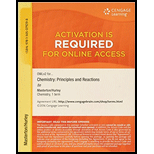
Concept explainers
(a)
Interpretation:
A net ionic equation for the reaction needs to be determined that takes place when 25 ml of 0.500 M iron (II) sulfate is combined with 35.0 ml of 0.332 M barium hydroxide.
Concept introduction:
Net ionic equation is the ionic equation in which reactants are written in the form of ions if they occur as ions in a reaction medium and product form are shown as combination of ions. The charges of ions and each atom in the reaction are balanced
Answer to Problem 61QAP
The net ionic equation is as follows:
Explanation of Solution
The equation of reaction of iron (II) sulfate with barium hydroxide is shown as follows:
Ionic equation for the above reaction is as follows:
As there are no spectator ions that appear on both sides of the arrow, net ionic equation is same as ionic equation.
Hence, net ionic equation is-
(b)
Interpretation:
The mass of the precipitate formed needs to be determined, when
Concept introduction:
Molarity is one of the ways to express the concentration. Formula to calculate molarity is as follows:
To calculate moles, the above formula can be rearranged as follows:
Answer to Problem 61QAP
The two precipitate formed are
Mass of
Mass of
Explanation of Solution
When iron sulfate is combined with barium hydroxide, two precipitates are formed. The equation for this gaseous reaction is shown below:
The two precipitate formed are
Hence, mass of
(c)
Interpretation:
The equilibrium concentrations of the ions in solutions when
Concept introduction:
Molarity is one of the ways to express concentration. Formula to calculate molarity is shown as follows:
To calculate moles, the above formula is rearranged as follows:
Limiting reactant in a reaction is that reactant which is completely used to form products.
Answer to Problem 61QAP
The equilibrium concentration of ions are as follows:
Explanation of Solution
When iron sulfate is combined with barium hydroxide, two precipitates are formed. The equation for this gaseous reaction is as follows:
The number of moles of
Draw ICE table,
Now,
The reaction is as follows:
So
The concentration of
The concentration of
As moles of
Hence,
Want to see more full solutions like this?
Chapter 15 Solutions
CHEMISTRY:PRIN.+REACTIONS-OWLV2 ACCESS
- how to get limiting reactant and % yield based off this data Compound Mass 6) Volume(mL Ben zaphone-5008 ne Acetic Acid 1. Sam L 2-propanot 8.00 Benzopin- a col 030445 Benzopin a Colone 0.06743 Results Compound Melting Point (°c) Benzopin acol 172°c - 175.8 °c Benzoping to lone 1797-180.9arrow_forwardAssign ALL signals for the proton and carbon NMR spectra on the following pages.arrow_forward7.5 1.93 2.05 C B A 4 3 5 The Joh. 9 7 8 1 2 7.5 7.0 6.5 6.0 5.5 5.0 4.5 4.0 3.5 3.0 2.5 2.0 1.5 1.0 ppm 9 7 8 0.86 OH 10 4 3 5 1 2 7.5 7.0 6.5 6.0 5.5 5.0 4.5 4.0 3.5 3.0 2.5 2.0 1.5 1.0 ppm 9 7 8 CI 4 3 5 1 2 7.0 6.5 6.0 5.5 5.0 4.5 4.0 3.5 3.0 2.5 2.0 2.21 4.00 1.5 2.00 2.07 1.0 ppm 2.76arrow_forward
- Assign the functional group bands on the IR spectra.arrow_forwardFind the pH of a 0.120 M solution of HNO2. Find the pH ignoring activity effects (i.e., the normal way). Find the pH in a solution of 0.050 M NaCl, including activityarrow_forwardPlease help me answer these three questions. Required info should be in data table.arrow_forward
- Draw the major organic substitution product or products for (2R,3S)-2-bromo-3-methylpentane reacting with the given nucleophile. Clearly drawn the stereochemistry, including a wedged bond, a dashed bond and two in-plane bonds at each stereogenic center. Omit any byproducts. Bri CH3CH2O- (conc.) Draw the major organic product or products.arrow_forwardTartaric acid (C4H6O6) is a diprotic weak acid. A sample of 875 mg tartaric acid are dissolved in 100 mL water and titrated with 0.994 M NaOH. How many mL of NaOH are needed to reach the first equivalence point? How many mL of NaOH are needed to reach the second equivalence point?arrow_forwardIncluding activity, calculate the solubility of Pb(IO3)2 in a matrix of 0.020 M Mg(NO3)2.arrow_forward
 Principles of Modern ChemistryChemistryISBN:9781305079113Author:David W. Oxtoby, H. Pat Gillis, Laurie J. ButlerPublisher:Cengage Learning
Principles of Modern ChemistryChemistryISBN:9781305079113Author:David W. Oxtoby, H. Pat Gillis, Laurie J. ButlerPublisher:Cengage Learning World of Chemistry, 3rd editionChemistryISBN:9781133109655Author:Steven S. Zumdahl, Susan L. Zumdahl, Donald J. DeCostePublisher:Brooks / Cole / Cengage Learning
World of Chemistry, 3rd editionChemistryISBN:9781133109655Author:Steven S. Zumdahl, Susan L. Zumdahl, Donald J. DeCostePublisher:Brooks / Cole / Cengage Learning Physical ChemistryChemistryISBN:9781133958437Author:Ball, David W. (david Warren), BAER, TomasPublisher:Wadsworth Cengage Learning,
Physical ChemistryChemistryISBN:9781133958437Author:Ball, David W. (david Warren), BAER, TomasPublisher:Wadsworth Cengage Learning, Chemistry: Principles and PracticeChemistryISBN:9780534420123Author:Daniel L. Reger, Scott R. Goode, David W. Ball, Edward MercerPublisher:Cengage LearningChemistry: Matter and ChangeChemistryISBN:9780078746376Author:Dinah Zike, Laurel Dingrando, Nicholas Hainen, Cheryl WistromPublisher:Glencoe/McGraw-Hill School Pub Co
Chemistry: Principles and PracticeChemistryISBN:9780534420123Author:Daniel L. Reger, Scott R. Goode, David W. Ball, Edward MercerPublisher:Cengage LearningChemistry: Matter and ChangeChemistryISBN:9780078746376Author:Dinah Zike, Laurel Dingrando, Nicholas Hainen, Cheryl WistromPublisher:Glencoe/McGraw-Hill School Pub Co





